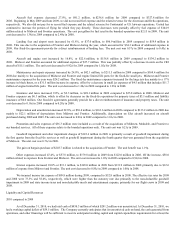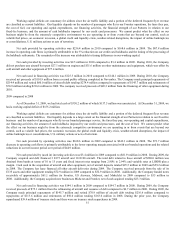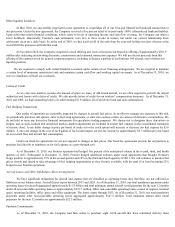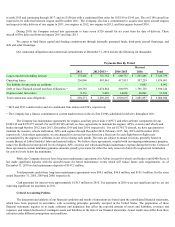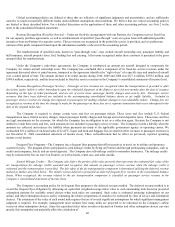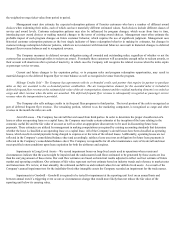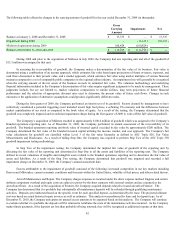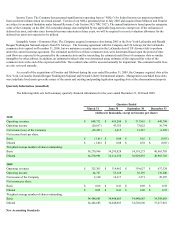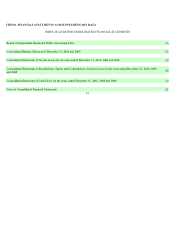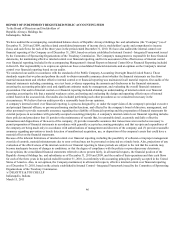Frontier Airlines 2010 Annual Report Download - page 65
Download and view the complete annual report
Please find page 65 of the 2010 Frontier Airlines annual report below. You can navigate through the pages in the report by either clicking on the pages listed below, or by using the keyword search tool below to find specific information within the annual report.the weighted-average ticket value from period to period.
Management must also estimate the expected redemption patterns of Frontier customers who have a number of different award
choices when redeeming their miles, each of which can have materially different estimated values. Such choices include different classes of
service and award levels. Customer redemption patterns may also be influenced by program changes, which occur from time to time,
introducing new award choices or making material changes to the terms of existing award choices. Management must often estimate the
probable impact of such program changes on future customer behavior, which requires the use of significant judgment. Management uses
historical customer redemption patterns as the best single indicator of future redemption behavior in making its estimates, but changes in
customer mileage redemption behavior patterns, which are not consistent with historical behavior can result in historical changes to deferred
frequent flyer revenue balances and to recognized revenue.
The Company measures its deferred revenue obligation using all awarded and outstanding miles, regardless of whether or not the
customer has accumulated enough miles to redeem an award. Eventually these customers will accumulate enough miles to redeem awards, or
their account will deactivate after a period of inactivity, in which case the Company will recognize the related revenue when the miles expire
as passenger service revenue.
Current and future changes to the expiration policy, or to program rules and program redemption opportunities, may result in
material changes to the deferred frequent flyer revenue balance as well as recognized revenue from the program.
Mileage Credits Sold – The Company has agreements with its co-branded credit card partner that require its partner to purchase
miles as they are awarded to the co-branded partner cardholders. The air transportation element for the awarded miles is included in
deferred frequent flyer revenue at the estimated fair value of the air transportation element and the residual marketing element is recorded as
cargo and other revenue when the miles are awarded. The deferred frequent flyer revenue is subsequently recognized as passenger service
revenue when the transportation is provided.
The Company also sells mileage credits in its frequent flyer programs to third parties. The travel portion of the sale is recognized as
part of deferred frequent flyer revenue. The remaining portion, referred to as the marketing component, is recognized as cargo and other
revenue in the month the miles are sold.
Aircraft Leases – The Company has aircraft that are leased from third parties. In order to determine the proper classification of a
lease as either an operating lease or a capital lease, the Company must make certain estimates at the inception of the lease relating to the
economic useful life and the fair value of an asset as well as select an appropriate discount rate to be used in discounting future lease
payments. These estimates are utilized by management in making computations as required by existing accounting standards that determine
whether the lease is classified as an operating lease or a capital lease. All of the Company’ s aircraft leases have been classified as operating
leases, which results in rental payments being charged to expense over the term of the related leases. Additionally, operating leases are not
reflected in the Company’ s consolidated balance sheet and accordingly, neither a lease asset nor an obligation for future lease payments is
reflected in the Company’ s consolidated balance sheet. The Company is responsible for all other maintenance costs of its aircraft and must
meet specified return conditions upon lease expiration for both the airframes and engines.
Impairments to Long-Lived Assets – We record impairment losses on long-lived assets used in operations when events and
circumstances indicate that the assets might be impaired and the undiscounted cash flows estimated to be generated by those assets are less
than the carrying amount of those items. Our cash flow estimates are based on historical results adjusted to reflect our best estimate of future
market and operating conditions. Our estimates of fair value represent our best estimate based on industry trends and reference to market rates
and transactions. We review, at least annually, the estimated useful lives and residual values for our definite lived assets. As a result of the
Company’ s annual impairment test for the indefinite-lived other intangible assets the Company recorded an impairment for the trade names.
Impairments to Goodwill – Goodwill is required to be tested for impairment at the reporting unit level on an annual basis and
between annual tests if a triggering event occurs or circumstances change that would more likely than not reduce the fair value of the
reporting unit below its carrying value.




